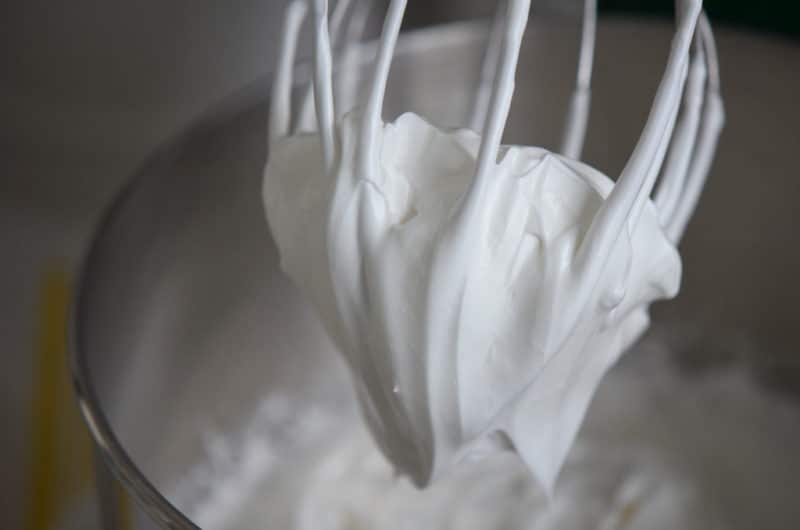How to make meringue
Jun 27, 2012
This post may contain affiliate links. Please read our disclosure policy.

What they say about literary technique is also true of culinary technique: you must first master the basics before you can take liberties with them. That’s why when we learned to whip egg whites at Tante Marie’s, we were given two tools, neither of which plugged into the wall: a balloon whisk and a copper bowl. My love of meringue sent me into a feverish whipping frenzy, and I loved watching my egg whites transform into a white, fluffy beauty in a gorgeous copper vessel. For my efforts I received in return a painful bad case of tennis elbow, which only seemed to heal as recently as a few months ago. So even though I wanted to continue my handiwork, I had no choice but to turn to the electric mixer.
That worked out fine anyway, because certain types of meringue, like the Italian meringue that is the basis for so many desserts, require the stand mixer—to try and make this meringue by hand would be reserved for the truly insane.

Meringue is simply whipped egg whites, which is used as a foundation for sweets like mousse, souffle, or in our case, a light ice cream. Italian meringue involves whipping hot sugar syrup into semi-whipped whites, a process that in effect cooks the whites and takes them to another level of glossy delightfulness. The sugar syrup stabilizes the whipped whites so they hold their shape, which is why meringue looks so fluffy and peaked atop lemon meringue pie or why it can be baked and dried into a crunchy cookie with curlicues on top.
To whip meringue:
- Start with room temperature egg whites; you get more volume out of them–but separate your eggs when they’re cold; it’s easier. I keep a tightly closed jar of egg whites in the refrigerator (the inverse of the pastry cream I make that requires yolks only). They last for months. Use your nose as your guide as to the freshness of your whites.
- Whip whites in an absolutely clean metal bowl (the bowl of your stand mixer). Any trace of fat or egg yolk will derail the meringue.
- Add a pinch of cream of tartar once the whites become foamy in the initial stage of beating. This contributes to the stabilization of the whipped whites.
- While the whites are whipping on medium speed to soft peaks, boil the sugar syrup. Coordinating the heating of the syrup and the beating of the whites is important. Take care not to over-whip the whites at this stage, or they’ll get dry and chunky. Julie Child famously said you’ve reached the correct thickness of your pre-sugared whites if you can turn the bowl of meringue over your head without fear of the whites dropping out. Go for it.
- Pour the hot syrup (232 degrees) very slowly into the stand mixer bowl between the whisk attachment (that is on and spinning) and the side of the bowl. The whites will gloss up and start to look like marshmallow. I need little else to have a good day than to witness this.
- Continue whipping until the mixture cools, which takes about 10 minutes. Readiness is indicated by touching your palm against the exterior of the mixing bowl; the meringue is ready when that is no longer hot.
You may think that this process, which is part of making our ice cream this week sans ice cream maker, is more laborious than driving over to the store and dropping down some cash for the ice cream machine. Or heading out to the ice cream parlor where a cone can be had simply for a few bucks and no effort other than licking it up before it melts. Perhaps. But then, perhaps you’re going to be intrigued by our recipe, and perhaps you’ll enjoy whipping whites with sugar syrup as much as I do, even without a copper bowl to admire.











Maureen,
next time I will definitely turn the bowl over my head, I mean, it’s a classical win-win situation 😀
Cheers
Tlaz
Maureen,
My Nonina (grandmother) made the best meringue! Looking forward to the ice-cream recipe!
Michael